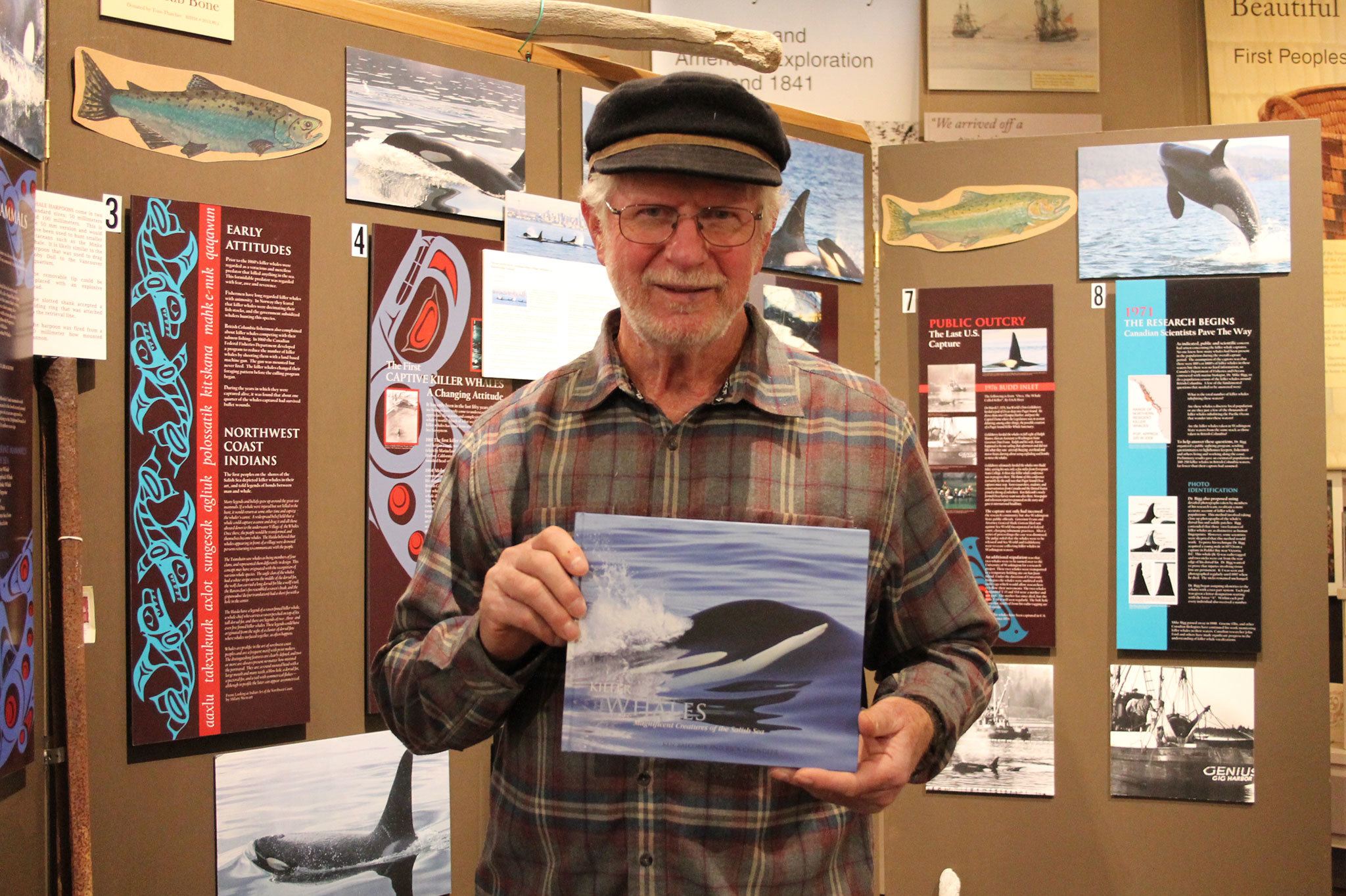If you live in the Pacific Northwest, you’ve probably heard a lot about killer whales.
Around here, there are sightseeing boat tours designed to bring people closer to the whales. There’s native Tribal art dedicated to honoring whales. And there are often protests to save the whales. But just how much do you really know about the killer whales that swim near here?
Rick Chandler and Ken Balcomb have something that can help — their new book, “Killer Whales, Magnificent Creatures of the Salish Sea.” The book, which was just published, addresses the whales in the Salish Sea, their capture, research, what we’ve learned about them, and the survival of whales. It is based on an exhibit that first went up at the Bainbridge Island Historical Museum in 2011.
As Chandler, who is the curator at the museum, explains, he met Balcomb years ago when they were both a part of a study by the Smithsonian Institute. They traveled in a military-type boat between Hawaii and Samoa, studying the birds and whales that swam and flew in the area.
“I was more the bird person at the time,” Chandler recalled. “But after that experience I became more aware of whales.”
After graduate school, Balcomb invited Chandler to Washington state in 1976 and soon after, the two were taking part in a government-funded project to survey the Orca population. (By the way, the first thing you need to know, if you don’t already, is that Orcas and killer whales are the same.)
“There was a whale hotline,” Chandler said. “People would call in when they saw a whale and we’d respond by going out with our cameras and our telephoto lenses and take pictures of them. Then we’d go home and in a darkroom in my basement, we’d develop the film and see what we had captured on film.”
They’d print the photographs and quickly they learned that whales travel in families (or pods).
“They have distinct markings and by doing sound recordings, we learned that they have distinct voices,” Chandler said.
The whales in this area are kept straight by naming the three pods that are here; J, K and L. Chandler said the lettering system was started in Canada and those were the next sequential letters.
As both men continued to study whales, they each took on responsibilities, Chandler with the museum, and Balcomb, who founded the Center for Whale Research on Friday Harbor in the San Juan Islands.
As museum curator, Chandler worked with Balcomb and designer Donna Keyser to create an exhibit for the Bainbridge Island Historical Museum. That exhibit went up in 2011, and it was about three years ago when a group of whale supporters met and began discussing how to capture their research in a manner that they could share with others.
They decided to turn the exhibit into a book, to benefit both the museum and the research center.
“We talked to the designer (Keyser) and asked if she thought her work could be converted to a book,” Chandler said. “She said she thought that would work. So we went looking for a publisher.”
It took a few years to get everything ready to print, and during that time both Chandler and Balcomb kept updating the statistics in the book (how many whales in each pod, how many new baby orcas, etc.). Finally, after finding a printing company in Hong Kong, the book is now in print.
Living in this area, Chandler said most people have a natural interest in whales.
“Seeing them in the wild is something that you can do around here,” he said. “Seeing them in capture (at aquariums) is interesting, but seeing them where they live makes them even more interesting.”
Chandler said one of the most interesting things about whales is that they are much like humans, in that they travel and live in families, and will care for each other and grieve when a family member dies.
As for their name, killer whales comes from their size, although they are not killers. Those in the waters around here are salmon eaters and won’t harm humans. And because the federal government uses the term “killer whales” in its sponsored research, he and Balcomb used it in their book.
“Some criticized the title of the book,” he said. “But all government publications use killer whales. They don’t shy away from that.”
Throughout the years, there have been captures of killer whales in Penn Cove near Whidbey Island. There have been issues with Navy sonar, which upsets the whales and their sensitive hearing. Whales are sometimes a political issue. And research shows that whales have been shot.
“The first captures had gunshot wounds,” he said. “It’s thought that fishermen shot at them to drive them away from their fishing nets.”
Although he knew a lot about whales before working on the book, he still learned new things.
“Probably the thing that surprised me the most was the graph on page 38 that shows the relationship between whale deaths and the availability of chinook (salmon) — their main food source,” he said. “It became very clear how important that relationship is.”
And Chandler said, his interest in whales continues.
“They are just very amazing,” he said.
“Next to humans, killer whales are the most widespread mammal on earth. They have their own cultural ethnicity in their own populations. They are just fascinating.”



